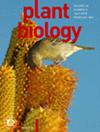Zoospore diversity and sexual reproduction in the lichen-forming genus Trebouxia: From neglected evidence to new facts
IF 3.6
3区 生物学
Q1 PLANT SCIENCES
引用次数: 0
Abstract

地衣形成属Trebouxia的游动孢子多样性和有性繁殖:从被忽视的证据到新的事实。
Trebouxia是绿藻中最常见的属之一,以光生物的形式出现在地衣中。然而,人们对它的生命周期仍然知之甚少。关于鞭毛细胞的矛盾信息削弱了我们对可能有性生殖的认识。本研究的目的是研究四种Trebouxia物种中鞭毛细胞的行为和命运,以更好地了解它们在生命周期中的作用。Trebouxia无菌培养在控制条件下进行。鞭毛细胞的细胞周期是用一种新的光学显微镜实时监测技术观察到的,通过扫描电子显微镜(SEM)更详细地验证了这一点。此外,分子方法被用于研究有性生殖的基因组证据。游动孢子有两种明显不同的形态,细长型和亚球形,这表明在未来的物种描述中应该认识到这种二态性。在三个物种中观察到长形配子的融合,其中一例记录了合子的形成和发育。扫描电镜图像以前所未有的细节提供了等离子体事件的进一步证据。分子分析证实了Trebouxia在8个基因组和1个转录组中存在关键减数分裂基因,为该属有性生殖提供了进一步的有力证据。本研究提供了一种新的方法来监测鞭毛细胞的命运随时间的变化,从而证明了两种鞭毛细胞的存在:具有两种明确形态的游动孢子,它们参与无性生殖,以及参与有性生殖的配子。
本文章由计算机程序翻译,如有差异,请以英文原文为准。
求助全文
约1分钟内获得全文
求助全文
来源期刊

Plant Biology
生物-植物科学
CiteScore
8.20
自引率
2.60%
发文量
109
审稿时长
3 months
期刊介绍:
Plant Biology is an international journal of broad scope bringing together the different subdisciplines, such as physiology, molecular biology, cell biology, development, genetics, systematics, ecology, evolution, ecophysiology, plant-microbe interactions, and mycology.
Plant Biology publishes original problem-oriented full-length research papers, short research papers, and review articles. Discussion of hot topics and provocative opinion articles are published under the heading Acute Views. From a multidisciplinary perspective, Plant Biology will provide a platform for publication, information and debate, encompassing all areas which fall within the scope of plant science.
 求助内容:
求助内容: 应助结果提醒方式:
应助结果提醒方式:


